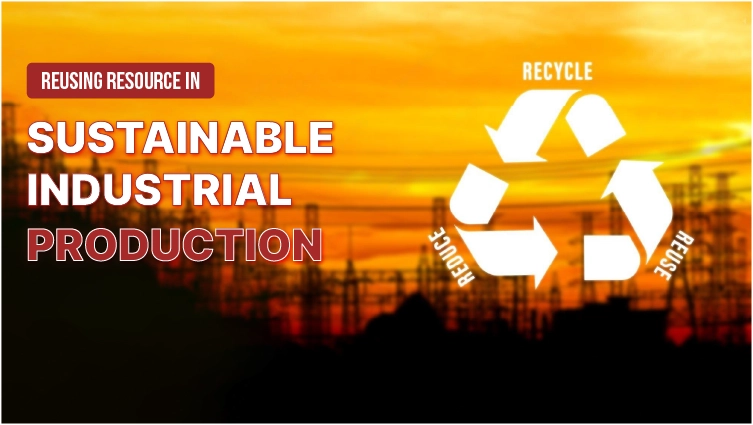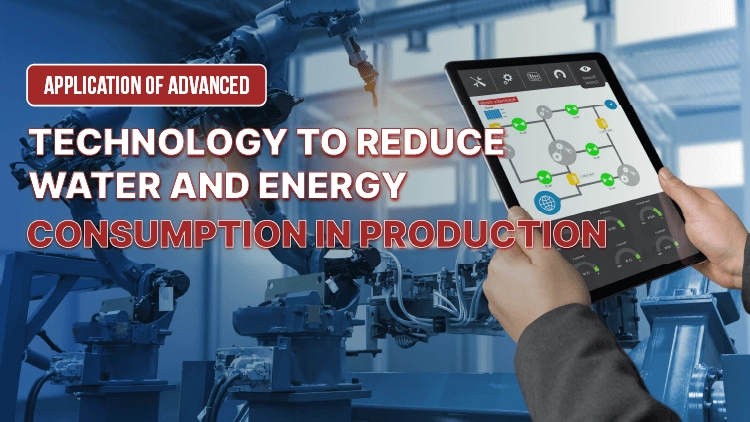Reusing resource in sustainable industrial production

Today, the problem of environmental pollution is one of the major challenges for the sustainable development of the economy and society. Industries, especially in the manufacturing sector, contribute significantly to environmental pollution. Up to now, the manufacturing industry is causing a large amount of emissions, causing air pollution to increase. Therefore, finding solutions to minimize negative impacts on the environment is inevitable for businesses today.
In the article below, join RX Tradex to learn about the importance of resource reuse in industrial production and the most popular resource reuse solutions in production today.
1. Overview of resource reuse in production
1.1. What is resource reuse in production?
What is resource reuse in production? This is a recycling method that reuses used materials or products to create new products. Instead of discarding them after use, these resources are collected, recycled, and reused for reuse in the manufacturing process, including recycling and processing materials such as metal, plastic, paper, and glass so that they can be reused in production. In addition, used products can also be reused or recycled to create new products or for different purposes, without causing negative impacts on the environment.
1.2. Current situation of environmental pollution in industrial production today
According to Environmental Protection Magazine, in Ho Chi Minh City, there are up to 800 factories, large enterprises and more than 30,000 production facilities causing serious environmental pollution. In Hanoi, there are 273 state-owned industrial bases and 104 facilities managed by Hanoi with 9 industrial clusters already established and 5 new industrial parks under construction. Some industries such as chemicals, fertilizers, mining and mineral processing have a large amount of wastewater containing many toxic elements that are discharged directly into rivers, ponds and lakes, polluting water sources. In particular, wastewater, garbage and emissions are becoming urgent issues in industrial parks today.
- Wastewater: Many industries such as chemicals, fertilizers, and mining produce large amounts of wastewater containing toxic substances such as acids, alkalis, heavy metals, and organic matter. This situation heavily pollutes clean water sources, affecting people's livelihoods and health.
- Regarding waste: annually, Vietnam produces about 15 million tons of garbage, of which industrial waste accounts for 17%. The accumulation of waste causes serious environmental and public health problems, especially hazardous waste from factories and industrial parks.
- In terms of emissions: the combustion of fuel in factories and industrial parks produces emissions that pollute the air, including dust and exhaust fumes. The treatment of exhaust gases at the source has not been implemented effectively, causing negative impacts on the health of the community and the living environment.
In this context, the radical solution of wastewater, garbage, and emissions is an urgent problem. There is a need for cooperation between businesses, governments and civil society organizations to promote the application of measures to treat and reuse resources effectively, contributing to environmental protection and improving the quality of life of communities.

2. How important is resource reuse in production?
Through a series of issues above, we can see that the reuse of resources brings a multitude of benefits not only in the manufacturing industry but also significantly affects the environment, such as:
- Environmental protection: One of the most obvious benefits of resource reuse in production is the reduction of waste and environmental pollution. Instead of discarding used resources into the environment, reuse helps reduce pressure on natural resources. This not only reduces the amount of waste dumped into the soil, water and air, but also minimizes the toxic impact on the ecosystem.
- Energy and resource savings: The process of reusing resources usually consumes less energy than producing from new resources. This reduces greenhouse gas emissions and saves precious resources such as water and oil. In addition, the reuse of resources also helps to minimize the exploitation of natural resources, thereby protecting the natural landscape and the species living in that environment.
- Enhanced economic efficiency: Reusing resources not only reduces production costs but also creates new business opportunities. Businesses can take advantage of recycled raw materials to produce new products and develop markets.
- Encourage creativity and innovation: The reuse of resources requires creativity in design and manufacturing processes. This encourages innovation and the development of new technologies, which in turn creates new products and services that benefit both businesses and consumers. At the same time, Creativity also helps to optimize the production process and enhance labor efficiency.
- Protecting resources for future generations: Reusing resources also plays an important role in protecting resources for future generations. By using resources more efficiently today, we are preserving a better living environment for generations to come, supporting the sustainable development and prosperity of society.
3. 5 The trend of resource reuse in industrial production is popular today
3.1. Trend of recycling and reusing plastic waste:
With the problem of plastic pollution globally, recycling and reusing plastic is becoming one of the important trends. Recycling technology and plastic production technology are increasingly developed to convert used plastics into new products, helping to reduce the amount of plastic waste and protect the environment.
- Plastic Recycling: This recycling process usually involves separating plastics from used products, cleaning them, and converting them into plastic beads to produce new products such as plastic bottles, bags, toys, and many others.
- Use recycled plastic: Instead of using virgin plastic, many businesses are turning to recycled plastic as raw materials for their products. This not only minimizes the amount of plastic waste but also saves resources and energy during production.
- Plastic collection and reuse programs: Plastic waste collection and reuse programs are being widely implemented around the world. Organizations and communities often organize campaigns to collect plastics from seas, rivers, and urban areas to then recycle and reuse them.
- ...
3.2. Trend of using renewable energy:
Using renewable energy such as solar, wind, hydropower, and thermal power from bioenergy is becoming an integral part of industries. The use of renewable energy reduces emissions and environmental impacts from traditional energy sources such as coal and oil.
- Solar energy: Solar power technology is increasingly widely applied in manufacturing. Installing solar panels on rooftops or on the surface of factories and production facilities helps businesses generate their own clean and sustainable energy sources.
- Wind power: Especially in areas with strong winds, the use of wind energy to produce electricity is becoming popular. The wind turbine blades are installed on tall poles that help take advantage of wind power to generate electricity.
- Water power: Hydropower is a traditional renewable energy source and is still widely used. Hydroelectric power plants use water runoff to produce electricity without causing carbon emissions.
- Bioenergy: The use of energy from biological sources such as biomass, biogas and ethanol is also increasingly interesting and developed. Manufacturing plants can use organic waste to produce energy, which minimizes the amount of waste and creates a clean energy source.

3.3. The trend of reusing metals and precious materials:
Recycling and reusing metals such as steel, aluminum, copper, and precious materials such as gold and platinum reduces the amount of natural resource extraction and saves energy during production.
- Metal Reuse: This process involves collecting, separating and recycling metals such as steel, aluminum, copper, and zinc from end products for the purpose of reusing in new production.
- Precious materials such as gold, platinum, silver, and palladium are commonly used in electronics and technology applications. Instead of exploiting natural resources, businesses are looking for ways to recycle and recover precious materials from old products to reuse in production.
- Reuse of materials in the production process: Instead of eliminating materials entirely, many businesses are looking for ways to reuse materials in their production processes. This can include the reuse of metal waste but can also apply to other materials such as wood, plastic and rubber.
- Development of reuse technology: Modern technology is being applied to optimize the reuse and recycling of precious materials and metals. Methods such as chemical methods and thermal recycling are being researched and developed to convert old products into high-quality recycled raw materials.
3.4. Trend of water reuse:
Water reuse technology is being widely applied in industries, especially in manufacturing and processing. The reuse of water reduces water consumption and water pollution, while improving production efficiency.
- Rainwater collection and reuse system: One method to reuse water is to collect rainwater from rooftops and other surfaces and reuse it for purposes such as watering plants, cooling or making domestic water. Rainwater collection and storage technology is increasingly developed and widely applied in both production and communities.
- Invest in water treatment technology: Invest in efficient water treatment systems that remove pollutants and create clean, reusable water. Businesses can use this treated water for purposes such as cooling, cooling systems, or domestic water.
3.5. Trend of reuse and recycling of electronic products:
With the development of technology, electronic products become popular but also generate a large amount of electronic waste when discarded. Reusing and recycling electronic components reduces the amount of e-waste and reutilizes the precious materials contained in them.
- Reuse of components and equipment: A common method for reusing electronic products is to reuse components and equipment from old products to repair or upgrade new products.
- Electronic Product Recall and Reuse Programs: Many manufacturers are implementing recall and reuse programs for their old electronic products. Used products are recalled, inspected and repaired (if necessary) before being resold or reused for other purposes.
- Materials such as metals, plastics, and glass from old appliances can be recycled to manufacture new products.
4. Conclusions
In short, reusing resources in industrial production not only helps businesses reduce negative impacts on the environment but also has the opportunity to build a sustainable business model to improve their competitiveness. However, to promote businesses towards a circular economy, support and cooperation from the business community and society are needed, along with interest and encouragement from governments and international organizations.
To gain a deeper understanding of sustainable production solutions and efficient resource reuse, businesses can participate in Vietnam Manufacturing Expo 2024. This will be an opportunity for businesses to connect, exchange and share with many leading experts in the industry, Visit many modern machinery technologies and learn more new knowledge in green production, contributing to building a bright and sustainable future for the next generation.






